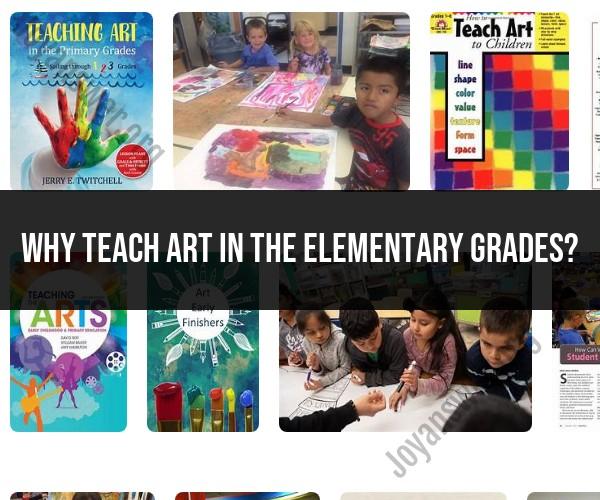Why teach art in the elementary grades?
Teaching art in elementary grades is crucial for several important reasons:
Fostering Creativity: Art education encourages and nurtures creativity in young children. It provides them with opportunities to explore their imagination, think outside the box, and express themselves in unique and innovative ways. Developing creativity at a young age can benefit children throughout their lives by enhancing problem-solving skills and promoting innovation.
Visual Literacy: Teaching art helps children develop visual literacy skills, which involve understanding and interpreting visual information. In today's visually oriented world, these skills are increasingly important. Art education enables students to analyze and appreciate visual elements in various forms of media, including advertisements, websites, and multimedia presentations.
Enhancing Fine Motor Skills: Creating art often involves fine motor skills, such as using pencils, brushes, scissors, and other tools. Engaging in art activities can improve hand-eye coordination and fine motor skills, which are essential for tasks like writing and manipulating objects.
Building Self-Expression: Art provides a means for children to express themselves in ways that words alone may not capture. It allows them to convey emotions, thoughts, and experiences that might be challenging to articulate verbally. This can be especially valuable for children who struggle with communication or have difficulty expressing themselves in traditional ways.
Boosting Confidence: Success in art projects can boost a child's self-esteem and confidence. When children see the tangible results of their creative efforts, they gain a sense of accomplishment and pride, which can have a positive impact on their overall self-worth.
Cultural Awareness: Art education exposes children to various cultures, traditions, and historical periods through visual art. They can learn about different art forms, artists, and artistic movements, fostering an appreciation for diversity and broadening their cultural awareness.
Critical Thinking and Problem Solving: Art challenges children to think critically and solve problems. They must make decisions about color, composition, materials, and techniques. This process enhances their analytical and problem-solving skills.
Emotional Development: Art can be an emotional outlet, allowing children to process and cope with their feelings. It provides a safe space to explore and manage emotions, which can be especially valuable during times of stress or change.
Interdisciplinary Learning: Art often integrates with other subjects such as science, math, history, and literature. Teaching art can reinforce learning in these areas, making education more interconnected and engaging for students.
Lifelong Appreciation of Art: Exposure to art in elementary grades can cultivate a lifelong interest in the arts. It may lead some students to pursue careers in the arts, but for all, it can instill an enduring appreciation for the value and beauty of artistic expression.
In summary, teaching art in elementary grades goes beyond creating beautiful artwork; it contributes to the holistic development of children by nurturing their creativity, self-expression, problem-solving abilities, and cultural awareness. It prepares them for a future in which creativity, visual literacy, and adaptability are increasingly important skills.
The Importance of Teaching Art in Elementary Grades
Teaching art in elementary grades is important for a number of reasons. Art education can help to:
- Foster creativity and imagination.
- Develop problem-solving skills and critical thinking skills.
- Encourage self-expression and communication skills.
- Improve fine motor skills and hand-eye coordination.
- Promote visual literacy and appreciation for art.
- Build cultural awareness and understanding.
Fostering Creativity: The Benefits of Art Education in Elementary Schools
Art education can help to foster creativity in elementary school students by providing them with opportunities to:
- Experiment with different materials and techniques.
- Explore their own ideas and express themselves creatively.
- Think outside the box and come up with new and innovative solutions to problems.
Creativity is an essential skill for success in all areas of life, and art education can help to develop this skill in students from a young age.
Art in Early Education: Cultivating Imagination and Expression
Art is a powerful tool for cultivating imagination and expression in early childhood. When young children engage in art activities, they are able to explore their own thoughts and feelings in a safe and supportive environment. Art can also help children to develop their language skills and their ability to communicate with others.
In addition, art education can help children to develop their fine motor skills and hand-eye coordination. These skills are essential for success in many academic areas, including reading and writing.
Overall, teaching art in elementary grades is important for a number of reasons. Art education can help to foster creativity, imagination, and expression in students. It can also help to develop problem-solving skills, critical thinking skills, fine motor skills, hand-eye coordination, visual literacy, and cultural awareness.
Here are some specific examples of how art education can benefit elementary school students:
- A student who is struggling to learn math may benefit from using art to visualize and solve problems.
- A student who is shy may use art to express themselves and communicate with others more confidently.
- A student with a learning disability may benefit from using art to improve their fine motor skills and hand-eye coordination.
- A student who is from a different culture may use art to share their cultural heritage with others.
Art education is a valuable part of a well-rounded education for all elementary school students.













